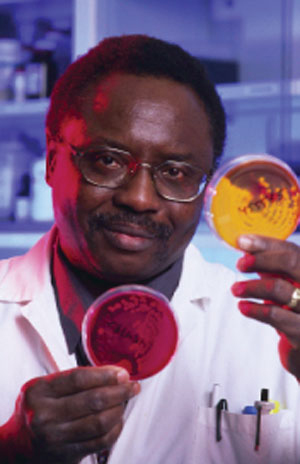
Researchers have developed a new, faster method for detecting salmonella from poultry environmental samples

|
| Current monitoring and control programs used to isolate and identify salmonella can be labour intensive and take 4-6 days to perform. New research has focused on developing faster, cost effective techniques that will allow for more rapid intervention. Advertisement
|
Researchers have developed a new, faster method for detecting salmonella from poultry environmental samples
.
Salmonella is the second leading cause of food-borne illness in Canada, with poultry and poultry products being major contributors to traceable disease. The poultry industry is now operating under increased regulatory pressure, greatly increasing the need for on-farm risk management of foodborne pathogens. The monitoring and control programs currently being used to isolate and identify salmonella have been predominantly based on conventional culture methods that are labour intensive and take 4-6 days perform.
Dr. Joseph Odumeru and his research team have been working on developing faster, cost effective isolation and identification techniques in order to provide industry with a more practical detection method. Their goal was to develop an Enzyme Linked Immunoabsorbant Assay (ELISA) screening step that could be added to currently used detection methods.
|
The effect of a sequential
reduction in protein and amino acids on laying hen performance as a means of tempering egg size
Dr. Steve Leeson,
University of Guelph
In layers, egg size is affected by both the size of the hen and
nutrition, particularly the intake of protein and the amino acid methionine. After 40 weeks of age, the usual concern is too large an egg size, since there is no economic incentive to produce extra large grade eggs and these have a higher incidence of cracks. Therefore, older layers should be fed less protein/methionine to help temper the natural increase in egg size. Just how far to reduce the protein is however, controversial. While controlling egg size is an important economic issue, few producers are willing to accept lower egg production as a consequence of any diet change. Another potential incentive for reducing crude protein (nitrogen) level in diets is to decrease nitrogen loading of manure. To date, little research has been conducted on this topic. In order to provide recommendations and information to industry on this important issue, Dr. Steve Leeson and his research team have been studying the response of layers to varying levels of protein/amino acid reduction through a complete laying cycle. Four complex diets were fed on different schedules. All production parameters of economic significance were measured, as well as estimates of nitrogen output in manure. Their findings? As the percentage of protein and amino acid was reduced in the diet, the hens ate more which counteracted any effects of the diet change. The researchers note, however, that sequential reduction in protein and amino acid had the greatest impact in the final six months of production. The diets used in this research are not ideal for use in decreasing egg size of older birds, and further work on the optimizing diets specifically for older birds is recommended. |
The researchers were successful in developing this technology, and poultry environmental samples were tested, including surface swabs from fans, floors, egg belts, manure and cages. Less frequently sampled areas included feed, pipes and ledgers, heaters, litter and feeders. The method was found to be very sensitive and successful for detecting and identifying a wide range of salmonella isolates.
Overall the method developed allows for screening of negative samples and the identification of suspect positive samples within 48 hours, versus the 4-6 days required by the standard culture methods. The new method allows poultry producers to have a rapid, simple, high throughput and cost effective method to provide enhanced surveillance ability for detecting clinically important salmonella at the farm.
Furthermore, the method allows for identification of viable isolates, which helps to provide valuable information on emerging strains and changes in the epidemiology of salmonella. This means that rapid interventions can be carried out to help reduce production losses.
Overall, the new method will aid in the reduction of on-farm and in-barn environmental risks, and enhance poultry and human health by improving salmonella testing for monitoring programs.
$600,000 Allocated for Research
The Chairman and Board of the PIC are pleased to announce this years project funding allocations (listed below) and would like to congratulate the successful applicants on being awarded these funds. We look forward to outcomes from these projects that will help move the industry forward in a sustainable and profitable manner.
FEATURED RESEARCHER
 |
Joseph A. Odumeru B.Sc., M.Sc., PhD.
Dr. Odumeru obtained his B.Sc. Honors in Microbiology and Immunology from the University of Western Ontario and his M.Sc. and PhD in Medical Microbiology from the University of Manitoba. His work experience includes 22 years of experience in diagnostic microbiology and research work in industrial, medical and food microbiology.
He is currently the Laboratory Director of Regulatory Services, Laboratory Services Division, and an Adjunct Professor, Department of Food Science, University of Guelph. He is responsible for food quality and safety testing services provided by the Division. His research interests include development of rapid methods for the detection, enumeration and identification of micro-organisms in food, water and environmental samples, molecular methods for tracking microbial contaminants in foods, automated methods for microbial identification, shelf life studies of foods and predictive microbiology.
His research publications include 62 publications and review papers in peer review journals, 70 abstracts and presentations in scientific meetings.
 PIC'S PICKS
PIC'S PICKS
Don’t forget the inaugural Poultry Innovation Conference taking place Nov. 10-11 at Bingemans in
Kitchener, Ont. This conference will feature brilliant speakers, good company and an industry gala dinner. Bring your friends and find out what you don’t know.
See the PIC website (www.poultryindustrycouncil.ca) for details or phone us at 519-837-0284.
Print this page